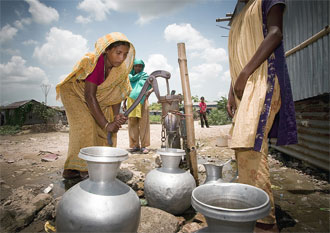Water scarcity affects emotions, study says.
Water shortages are linked to emotional distress among people living in poor urban areas, according to a study an ASU researcher collaborated on.
Amber Wutich, an assistant professor in the School of Human Evolution and Social Change, and Kathleen Ragsdale, an assistant professor in the Department of Sociology, Anthropology and Social Work at Mississippi State University, conducted the study that examined the extent to which water-related emotional distress is linked with water insecurity. Unequal distribution of water between rich and poor people was a major factor.
In their paper titled “Water insecurity and emotional distress: Coping with supply, access and seasonal variability of water in a Bolivian squatter settlement,” published in a 2008 edition of Social Science and Medicine, the pair observed different aspects of water insecurity.
Wutich said the study examined three dimensions of water insecurity: inadequate water supply, insufficient access to water and dependence on seasonal water sources.
“Recent research suggests that insecure access to key resources is associated with negative mental health outcomes,” Wutich said. “Many of these studies focus on drought and famine in agricultural, pastoral and foraging communities.”
Wutich said her study is the first to systematically examine community patterns of water insecurity in an urban setting.
The study was conducted in 2004 and 2005 through face-to-face survey interviews with a random sample of 72 household heads in Villa Israel, a squatter settlement of Cochabamba, Bolivia. Participants were asked how they felt emotionally about the water situation and were given four options: fear, worry, anger and bother.
Interviews were conducted four times over an eight-month period to capture variation in experiences at the height of Bolivia’s wet and dry seasons, Wutich said.
At the conclusion of the research, she said, only one of the four tested variables was proven to cause emotional distress.
“We found that only inequities in the distribution of water was significantly related to emotional distress,” Wutich said.
Wutich explained that in a market system of water distribution, water is not equally dispersed amongst the community, causing many poor residents to face water shortages.
According to the World Health Organization’s Web site, 1.1 billion people throughout the world lack adequate water provisions, and 2.2 million people die as a result of water-related illnesses each year.
In their paper, Wutich and Ragsdale quote some of the people they met in Bolivia in relationship to their water shortage.
“What I dislike about living here is that there is no water, the streets are dirty and there is no sewer, all of this is very uncomfortable,’” said one Bolivian woman. “‘With more water, I could clean my house, wash the bathroom.’”
The study concluded her emotional distress was common among the urban poor.
“These results suggest that water-related emotional distress develops as a byproduct of the social and economic negotiations people employ to gain access to water distribution systems in the absence of clear procedures or established water rights, rather than as a result of water scarcity per se,” Wutich said.





